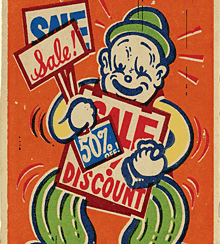Kicking the Sales Promotion Habit
Addiction to discounts is costly for retailers, but in moderation, promotions can boost profits and brand value.
It’s a tough world for retailers. New technologies enabling consumers to compare products and prices online have permanently changed the in-store shopping experience. Meanwhile, a sluggish economy and rising competition are testing consumers’ brand loyalty. Many retailers are responding with price promotions in a bid to keep people coming through the doors. But this short-term fix often exacerbates the very problems retailers aim to remedy. Over time, promotions train consumers to buy only when there’s a sale, and each new round of discounts must be deeper than the last to get their attention. As prices fall, margins suffer. Any incremental revenue gains from promotions eventually shrink as the sale sign becomes a fixture in store windows. Most troubling is the long-term damage to a retailer’s brand when consumers come to see it as a place that always has sales.
In short, the overuse of promotions can become an addictive behavior that can deeply damage a company’s brand identity. Yet a drastic change to eliminate promotions is not the answer: Witness the J.C. Penney Corporation’s failed attempt in early 2012 to purge the word sale from its marketing playbook in favor of everyday low pricing. Customers conditioned to expect frequent, heavily advertised discounts at J.C. Penney stayed away. In the three months following the change, sales fell 20 percent and store traffic dropped 10 percent. It cost the executive overseeing merchandising and marketing his job. (As of August 2012, CEO Ron Johnson continued to support the retailer’s transformation toward everyday low pricing, despite these early setbacks.)
Promotions are a reality in today’s marketplace, but they don’t have to hurt your business. Like so many other potentially addictive behaviors, promotions can be healthy in moderation. Used judiciously, they can boost sales and profitability, while enhancing a brand and creating a competitive advantage. The following five steps can help retailers build an effective promotions capability, consistent with their brand positioning and customer expectations, and in support of their company’s long-term goals.
Step 1: Acknowledge the problem. Accept that the current approach isn’t working, and must change. More retailers are coming to this realization as their financial results continue to falter. They’ve also been disappointed with new digital promotional options, such as Groupon-style “daily deals” that flood retailers with shoppers who seldom become repeat customers.
Step 2: Evaluate current promotions. Take stock of existing discount methods, such as in-store promotions, coupons, loyalty cards, discounts for credit card users, and markdowns, as well as the frequency with which each is used. These discount methods can be good or bad, depending on the retailer’s overall objectives. Enhancing awareness of the differences between types of promotions and how each affects critical factors such as profitability and brand perception enables retailers to choose those that best serve their goals.
Identifying such differences requires a rigorous approach to categorizing promotions and determining the incremental impact each has on key drivers of profitability, such as units sold, store traffic, conversion of traffic into sales, units per transaction, and average gross margin per unit sold. First, retailers need to understand the key characteristics that differentiate promotions — for example, eligibility (is the promotion available to all customers or only a subset?), product inclusion (which products are included in the promotion?), and merchandising support (is the promotion supported by advertising, either in stores or through general media?). After considering these key characteristics, retailers should match promotions with results, adjusting for various effects. In specialty retail stores, for instance, traffic varies by time of year (it is higher between Thanksgiving and Christmas than during other times of the year) and day of the week (during an average week, traffic is highest on Saturday and lower at the beginning of the workweek). Next, retailers should use regression analysis to calculate the incremental impact of the different promotions on each driver of profitability and estimate what that driver’s level would have been without the promotion. This analysis shows which types of events bring more shoppers to the store, which ones cause more shoppers to buy, and which ones lead them to put more items in their baskets. Finally, retailers need to compute the profitability of each type of promotion, basing it on incremental gross margin.
The most effective promotions tend to be targeted to selected customers; such promotions include “friends and family” events, loyalty club discounts, and other discrete efforts to reach particular groups. These tend to drive store traffic and often give a bigger boost to sales and profits with less risk to the brand. Giving coupons to shoppers to use the next time they come to the store also tends to drive conversion. By comparison, promotions open to all customers and trumpeted in store signs and media advertising (for example, across-the-board “percent-off” discounts) typically provide less incremental gross margin benefit while posing more brand risk. The more frequent and widespread such a promotion is, the more it cheapens the brand in consumers’ eyes.
Step 3: Lay out a path to recovery. Retailers should first ensure that a unified plan that aligns their promotions and brand image is in place. Neiman Marcus and Nordstrom have accomplished this by bolstering their brands and bottom lines through tactics such as targeting discounts to loyalty club members and offering only infrequent storewide sales that encourage shoppers to stock up.
Increasing coherence requires collaboration between business units that often operate in silos. But if a retailer’s sales and marketing staffs work together, they can develop reinforcing capabilities to create synergies between promotions and brands. Effective promotions activate brand messages and support consumer strategies. For example, promotions can jump-start a product launch by giving customers an incentive to try the new offering.
Start slowly; consumers don’t like sudden changes in familiar practices. J.C. Penney learned this the hard way, as did Walmart when it added more deep “rollbacks” (temporary price reductions) to its longtime strategy of “everyday low pricing” in the summer of 2010 in an effort to stimulate sales. Customers were confused, which led Walmart to return to its original strategy just a few months later.
Gradually phase out the promotions that are most harmful to your brand and that resonate least with consumers, while emphasizing those that serve both your brand and financial objectives. Using the knowledge and techniques developed in Step 2, sketch out a range of options for your new promotions strategy.
Step 4: Track your progress. Monitor “healthy” metrics that show how your new promotions strategy affects your long-term goals. For example, tracking profit growth tells you whether promotions are driving enough additional gross margin from selling more units at lower prices to offset the lost gross margin from not selling at the higher original prices. Tracking baseline sales shows the strength of your brand by measuring sales made without promotions. It’s one of the best signs that investing in your brand is paying off. You should also keep track of the frequency of promotions: How many days each year do you offer them? The higher the number, the greater the risk to your brand. One leading specialty apparel retailer didn’t realize how serious its promotion addiction had become until it began to track all its discounting activity. It was running promotions on more than 90 percent of the days its stores were open. Finally, monitor the percentage of sales at different stages of the pricing life cycle — at regular price, at promotional price, and on markdown. The higher the percentage of sales at earlier stages, the better.
At the same time, ignore “unhealthy” metrics that could lead you back into a promotions strategy that can hurt your brand and bottom line. For example, focusing on revenue growth reinforces the “sales at any cost” mentality that retailers need to shake.
Step 5: Persevere. Recovery is a marathon, not a sprint. As you examine the key metrics, remember to measure success from a long-term perspective rather than fixating on the immediate impact of individual promotions. Short-term metrics capture neither the potential brand damage from promotions nor the benefits of brand building, which bears fruit over time. Companies that try to change their promotional habits often panic when short-term sales drop, and they revert to their old ways. They don’t realize that the initial effect of cutting back on discounts is almost always a decline in sales. But a hasty retreat into poorly planned, last-minute promotions is not the answer. It only increases the damage to a brand. Ride out the ups and downs, stay focused on the long term, and embed your goals in the company culture to make sure the change takes hold. Ultimately, you will replace your harmful addiction with a powerful new promotions capability that strengthens your brand and your bottom line.![]()
Reprint No. 00134
Author profiles:
- David Ganiear is a principal with Booz & Company’s consumer and retail practice, and is based in Dallas.
- Karla Martin is a partner with Booz & Company’s consumer and retail practice, and is based in San Francisco.




